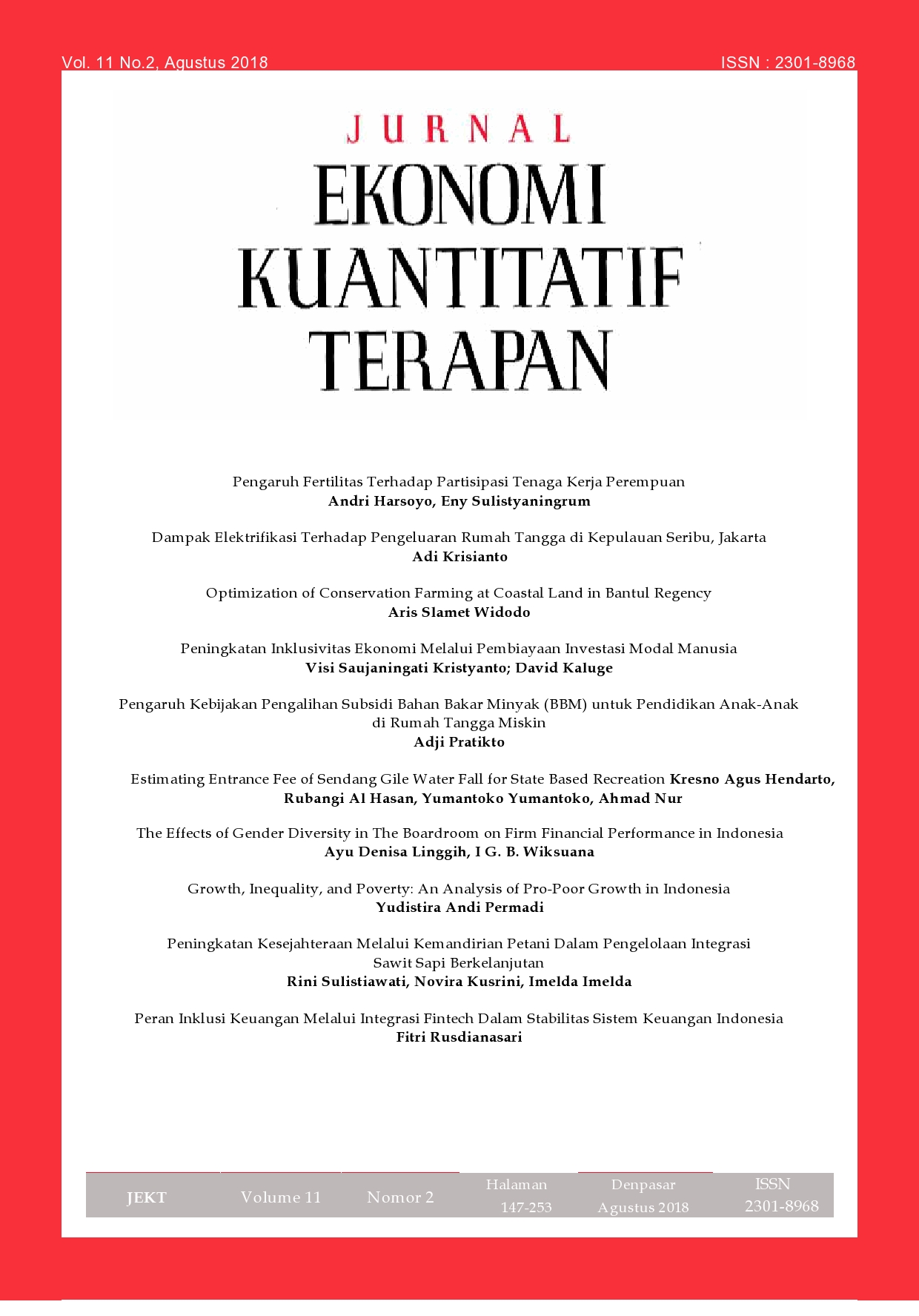Optimization of Conservation Farming at Coastal Land in Bantul Regency
Abstract
The aims of this study are to analyse the optimum resource allocation of conservational farming at coastal lands and to examine the influence of substitution of external input by internal input toward the income of farmers at coastal areas. The research method applied in this study was a survey method. The site of this study was determined purposively covering the areas along Samas coastal line at Srigading and Gadingsari Villages, Sanden District, Bantul Regency of Yogyakarta Special Province. The sampling was conducted trough proportional random sampling and based on the number of population, the samples were then determined 110 people. The findings conclude that the optimum resource allocation of conservational farming at sandy coastal areas at rainy season is by planting shallot 0.052 ha (52%), eggplant 0.032 ha (32%) and sweet potatoes 0.016 ha (16%), In the dry season 1, the optimum resource allocation is by planting shallot 0.022 ha (22%), chili 0.022 ha (22%) and sweet potatoes 0.051 ha (51%). In the dry season 2, optimum allocation of conservational farming is by planting chili 0.062 ha (62%) and sweet potatoes 0.038 ha (38%). The optimum resource allocation has influence the substitution of inorganic nutrient element by organic nutrient elements of: 28.1% N, 28.28% P and 20,55 % K. The maximum income in the optimal resource allocation of input is Rp 11,647,110.-/year.
Downloads
References
Balai Penelitian Kehutanan Solo, 2010. Laporan Hasil Penelitian: Model Rehabilitasi Lahan dan Konservasi Tanah Pantai Berpasir. Surakarta.
Balai Pengkajian Teknologi Pertanian Yogyakarta, 2006. Sistem Pengairan Sumur Renteng. Buku Panduan Teknologi Pertanian. Yogyakarta
Budiyanto G., 2005. Dampak Aplikasi Batuan Zeolit Alam dan Nitrogen Terhadap Keragaan Vegetatif Tanaman Jagung di Lahan Pasir Pantai. Jurnal: Agr-UMY, XIV, (1): 1-13.
Budiyanto, G., 2010. Pengaruh Bahan Organik dan Pupuk N Terhadap Beberapa Sifat Tanah, Pertumbuhan dan Hasil Jagung (Zea mays,L.) Di Lahan Pasir Pantai selatan Kulon Progo. Disertasi Program Pasca Sarjana Universitas Padjadjaran Bandung. Jawa Barat.
Dirjen Tanaman Pangan, 1992. Pedoman Bidang Konservasi Lahan: Sistem Pertanian Dalam Jalur (Strip Cropping). Departemen Pertanian. Jakarta.
FAO. 2005. The Importance of Soil Organic Matter, Key to Drought-resistant Soil and Sustained Food and Production. FAO of the United Nations Rome. 95p.
Haryadi B., 2009. Model Rehabilitasi Lahan dan Konservasi Tanah Pantai Berpasir. Laporan Hasil Penelitian, Badan Penelitian dan Pengembangan Kehutanan. Surakarta.
Juarini, Widodo S., Masyhuri dan Hartono S., 2002. Perilaku Petani Terhadap Risiko Usahatani di Lahan Pantai Kabupaten Kulonprogo. Universitas Gadjah Mada. Jurnal: Agro Ekonomi 9(2), 1-16.
Kumbhakar, S. C., and C. A. K. Lovell. 2000. Stochastic Frontier Analysis. Cambridge University Press.
Prasetyo, G., 2006. The role of coastal forests and trees in protecting against coastal erosion. Proceedings of the Regional Technical Workshop on Coastal Protection in the aftermath of the Indian Ocean tsunami: what role for forest and trees?. Khao Lak, Thailand, 28-31 August 2006.
Suhardjo, Suratman, Prihantini, T. dan Ritung, S. 2000. Lahan Pantai dan Pengembangannya dalam Sumberdaya Lahan Indonesia dan Pengelolaannya. Pusat Penelitian Tanah dan Agroklimat, Bogor.
Sukresno. 1999. Kajian Konservasi Tanah dan Air pada Kawasan Pantai Berpasir di DIY, Proyek P2TPDAS KBI, BTPDAS, Badan Litbang Kehutanan, Surakarta.
Sukresno, Mashudi, A.B. Supangat, Sunaryo & D. Subaktini. 2000. Pengembangan Potensi Lahan pantai dengan Budidaya Tanaman Semusim di Pantai Selatan Yogyakarta. Prosiding Seminar Nasional. Pengelolaan Ekosistem Pantai dan Pulau-Pulau Kecil dalam Konteks Negara Kepulauan. Fak. Geografi UGM. Yogyakarta.
Triatmodjo, Bambang. 1999. Teknik Pantai. Beta Offset. Yogyakarta.
Waluyati L., R., 2000. Pola Tanam Optimal Pada Lahan Pantai Di Kabupaten Kulonprogo. Jurnal: Agro Ekonomi. Universitas Gadjah Mada. 40-50.




















